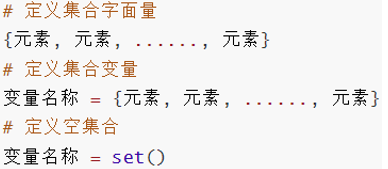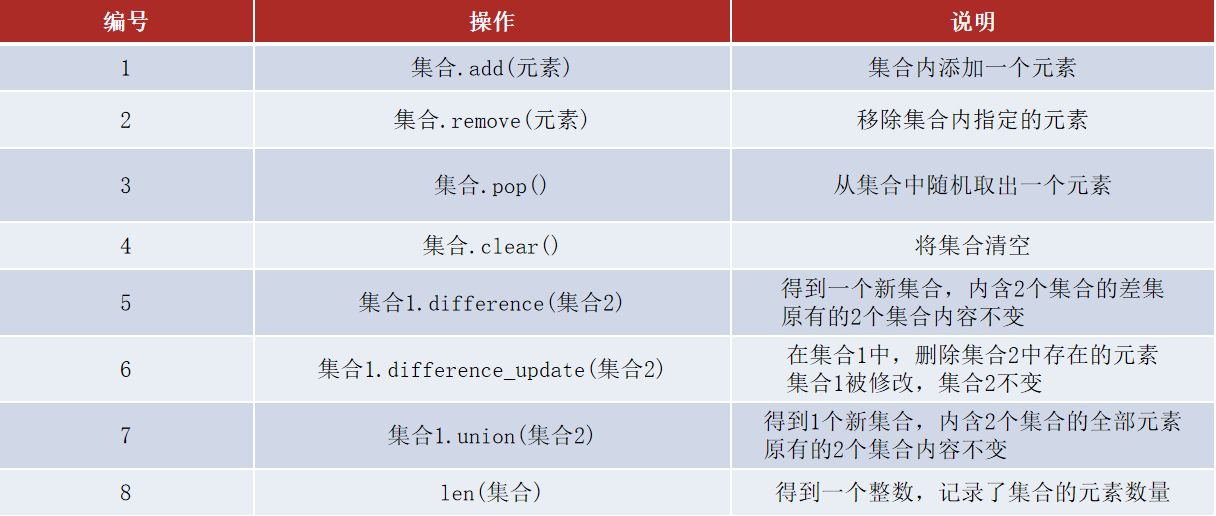集合
-
集合最主要的特点就是:不支持元素的重复(自带去重功能)、并且内容无序
-
语法

-
方法

-
代码案例
# 定义集合
my_set = {"传智教育", "黑马程序员", "itheima", "传智教育", "黑马程序员", "itheima", "传智教育", "黑马程序员", "itheima"}
my_set_empty = set() # 定义空集合
print(f"my_set的内容是:{my_set}, 类型是:{type(my_set)}")
print(f"my_set_empty的内容是:{my_set_empty}, 类型是:{type(my_set_empty)}")
# 添加新元素
my_set.add("Python")
my_set.add("传智教育") #
print(f"my_set添加元素后结果是:{my_set}")
# 移除元素
my_set.remove("黑马程序员")
print(f"my_set移除黑马程序员后,结果是:{my_set}")
# 随机取出一个元素
my_set = {"传智教育", "黑马程序员", "itheima"}
element = my_set.pop()
print(f"集合被取出元素是:{element}, 取出元素后:{my_set}")
# 清空集合, clear
my_set.clear()
print(f"集合被清空啦,结果是:{my_set}")
# 取2个集合的差集
set1 = {1, 2, 3}
set2 = {1, 5, 6}
set3 = set1.difference(set2)
print(f"取出差集后的结果是:{set3}")
print(f"取差集后,原有set1的内容:{set1}")
print(f"取差集后,原有set2的内容:{set2}")
# 消除2个集合的差集
set1 = {1, 2, 3}
set2 = {1, 5, 6}
set1.difference_update(set2)
print(f"消除差集后,集合1结果:{set1}")
print(f"消除差集后,集合2结果:{set2}")
# 2个集合合并为1个
set1 = {1, 2, 3}
set2 = {1, 5, 6}
set3 = set1.union(set2)
print(f"2集合合并结果:{set3}")
print(f"合并后集合1:{set1}")
print(f"合并后集合2:{set2}")
# 统计集合元素数量len()
set1 = {1, 2, 3, 4, 5, 1, 2, 3, 4, 5}
num = len(set1)
print(f"集合内的元素数量有:{num}个")
# 集合的遍历
# 集合不支持下标索引,不能用while循环
# 可以用for循环
set1 = {1, 2, 3, 4, 5}
for element in set1:
print(f"集合的元素有:{element}")
- 特点
可以容纳多个数据
可以容纳不同类型的数据(混装)
数据是无序存储的(不支持下标索引)
不允许重复数据存在
可以修改(增加或删除元素等)
支持for循环
- 案例1
my_list = ['黑马程序员', '传智播客', '黑马程序员', '传智播客',
'itheima', 'itcast', 'itheima', 'itcast', 'best']
# 定义一个空集合
my_set = set()
# 通过for循环遍历列表
for element in my_list:
# 在for循环中将列表的元素添加至集合
my_set.add(element)
# 最终得到元素去重后的集合对象,并打印输出
print(f"列表的内容是:{my_list}")
print(f"通过for循环后,得到的集合对象是:{my_set}")
- 案例2
# 求并集、交集、差集、对称差集
set1 = {1, 2, 3, 4, 5}
set2 = {4, 5, 6, 7, 8}
print(set(set1) | set(set2))
print(set(set1) & set(set2))
print(set(set1) - set(set2))
print(set(set2) - set(set1))
print(set(set2) ^ set(set1))

 浙公网安备 33010602011771号
浙公网安备 33010602011771号